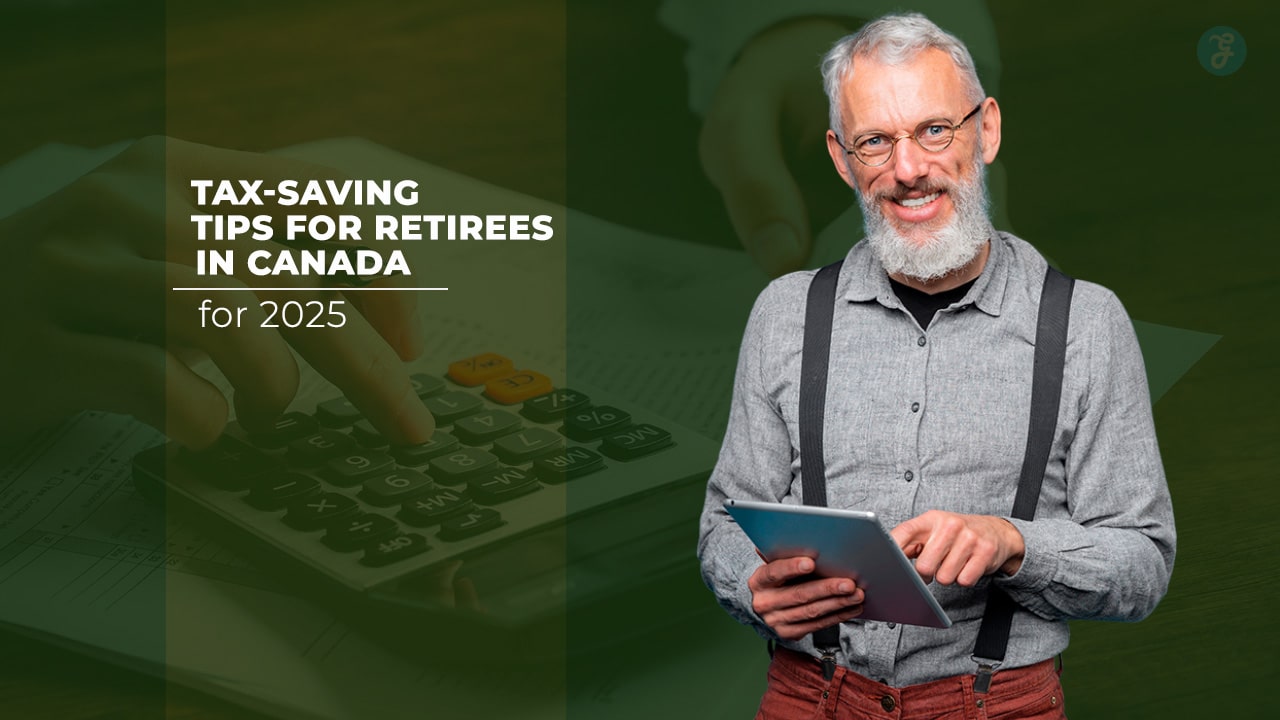Retirement is a time to reap the rewards of decades of hard work. However, even during retirement, managing taxes remains crucial to ensure financial security.
Without proper planning, taxes on pensions, savings withdrawals, and other income streams can reduce the funds retirees depend on for a comfortable life.
Fortunately, Canada offers several tax-saving strategies specifically designed for retirees.
This guide presents 10 tax-saving tips for retirees in Canada, providing actionable insights to help you keep more of your money while complying with tax laws. Let’s dive into the strategies that will secure your financial future.
Why Tax-Saving Strategies Matter for Canadian Retirees?
The Importance of Managing Taxes in Retirement
Even in retirement, income sources such as pensions, RRIFs, and investments are taxable, and failing to optimize your tax strategy can lead to unnecessary expenses. Taxes can also affect government benefits like the Old Age Security (OAS) or Guaranteed Income Supplement (GIS), which are subject to clawbacks if income thresholds are exceeded.
Proper tax planning enables retirees to:
- Reduce taxable income.
- Maximize the value of tax credits and deductions.
- Protect savings from erosion due to high tax rates.
Example: A retiree with $60,000 in annual income may save thousands by implementing income splitting, charitable donations, and TFSA contributions strategically.
Overview of Canada’s Retirement Tax Landscape for 2025
Canada’s tax system offers a range of benefits and credits to help retirees reduce their tax burden:
| Tax Tool | Details |
| Age Amount Tax Credit | A credit for seniors aged 65+, reduced at higher income levels. |
| TFSA Contributions | Tax-free growth and withdrawals without impacting income-tested benefits. |
| Medical Expense Deductions | Claim eligible healthcare costs exceeding 3% of net income or $2,635. |
| Pension Income Splitting | Split up to 50% of eligible pension income with a spouse for tax savings. |
Understanding and applying these benefits ensures retirees keep more of their income.
10 Practical Tax-Saving Tips for Retirees in Canada
1. Maximize Pension Income Splitting
Pension income splitting is one of the most effective tax-saving strategies for retirees in Canada. It allows couples to transfer up to 50% of eligible pension income from the higher-income spouse to the lower-income spouse.
This reduces the overall tax burden by taking advantage of lower tax brackets and tax credits available to the lower-income spouse. Eligible income includes RRIF withdrawals and private pension payments, but excludes OAS and CPP income. By carefully splitting income, couples can save thousands annually while maintaining a balanced income. This strategy is particularly beneficial for couples with significant income disparities.
Key Table:
| Scenario | Before Splitting | After Splitting | Tax Savings |
| Spouse A (Higher) | $60,000 | $30,000 | $3,500 annually |
| Spouse B (Lower) | $10,000 | $30,000 |
2. Claim the Age Amount Tax Credit
The age amount tax credit is a valuable tool for seniors aged 65 and older. It’s a non-refundable credit designed to reduce taxes owed, particularly for retirees with moderate incomes. For 2025, the credit phases out for higher income levels, making it essential to monitor taxable income.
Combining this credit with income splitting or strategic withdrawals from RRSPs can help retirees stay under the income threshold and maximize their savings. For instance, a retiree earning $42,000 can reduce their taxable income to $38,000 using pension splitting, qualifying for the full age amount credit, which can save hundreds of dollars.
| Net Income Range | Credit Value |
| Up to $40,000 | Full credit ($8,396) |
| $40,001–$90,000 | Partial credit |
| Over $90,000 | No credit |
3. Contribute to a Tax-Free Savings Account (TFSA)
The TFSA remains an invaluable savings tool for retirees, offering tax-free growth and withdrawals. Unlike RRSPs, withdrawals from a TFSA do not count as taxable income, ensuring retirees stay below income thresholds for benefits like the OAS and GIS. For 2025, the annual contribution limit is $6,500, and unused room carries forward indefinitely.
This flexibility makes the TFSA a perfect option for reinvesting RRIF withdrawals or emergency savings. For instance, a retiree with $88,000 in unused contribution room can shield a significant portion of their savings from taxation, preserving funds for long-term financial security.
| Year | Annual Limit | Cumulative Room |
| 2025 | $6,500 | $88,000+ |
4. Take Advantage of the Pension Income Credit
The pension income credit allows retirees to claim a federal tax credit on up to $2,000 of eligible pension income. It’s a simple yet effective way to lower tax liabilities, especially for retirees with RRIF or RPP income. Retirees without a pension can convert a small portion of their RRSP into a RRIF to qualify for this credit.
Combining this credit with income splitting or medical expense deductions enhances its effectiveness, particularly for retirees with moderate incomes. By using this credit alongside other strategies, seniors can save hundreds each year while reducing overall taxable income.
| Eligible Income | Eligible for Credit? |
| RRIF Withdrawals | Yes |
| CPP/OAS Payments | No |
5. Defer Your Canada Pension Plan (CPP) Payments
Deferring CPP payments can significantly increase retirement income. For every month you delay receiving CPP after age 65, your benefits increase by 0.7%, resulting in a 42% boost by age 70. This strategy is especially beneficial for retirees with other income sources during early retirement.
For example, a retiree who defers CPP until age 70 receives $1,704 monthly, compared to $1,200 at age 65. While deferring isn’t suitable for everyone, especially those with health concerns, it’s a powerful tool for ensuring higher income later in life when savings may dwindle.
| Start Age | Benefit Increase | Monthly Payment |
| 65 | Base amount | $1,200 |
| 70 | +42% | $1,704 |
6. Withdraw from RRSPs Strategically
Strategic withdrawals from RRSPs can help retirees manage their taxable income and avoid higher taxes later. By withdrawing smaller amounts before converting RRSPs to RRIFs at age 71, retirees can “fill up” lower tax brackets and reduce mandatory withdrawal impacts.
For instance, withdrawing $10,000 annually from an RRSP between ages 65 and 70 can minimize the tax burden and preserve OAS benefits. Proper planning ensures retirees avoid large tax hits and maintain financial flexibility during retirement.
| Age | Minimum RRIF Rate | Taxable Withdrawal ($100,000 RRIF) |
| 71 | 5.28% | $5,280 |
7. Use Charitable Donations for Tax Credits
Charitable donations offer retirees a meaningful way to give back while reducing taxes. Federal and provincial tax credits combined can reduce taxes owed by up to 40% of the donation amount. For instance, donating appreciated securities eliminates capital gains taxes while still qualifying for donation credits. Retirees can maximize savings by combining donations with their spouse or donating in bulk for larger credits. This strategy not only benefits the retiree financially but also supports important causes in their community.
| Donation Amount | Federal Credit | Provincial Credit (ON) |
| $2,000 | 29% | 11.16% |
8. Claim Medical Expense Deductions
Medical expenses are a significant cost in retirement but can be deducted from income if they exceed a set threshold. Eligible expenses include prescription drugs, dental care, and home modifications for accessibility.
Combining expenses with a spouse can help exceed the minimum threshold and maximize deductions. For instance, a couple with $8,000 in combined medical expenses can save significantly by claiming them on the lower-income spouse’s return.
| Expense Type | Eligible for Deduction? |
| Assisted Living Costs | Yes |
9. Move to a Tax-Friendly Province
Where you live in Canada significantly impacts the taxes you pay in retirement. Each province and territory has its own tax structure, with varying rates for income, sales, and property taxes. Relocating to a province with lower tax rates can lead to substantial savings over time.
For example, Alberta has one of the lowest provincial income tax rates at 15%, while Quebec’s top rate exceeds 25%. In addition, provinces like Alberta and British Columbia have no health premiums, adding to the savings. Moving can be especially beneficial for retirees with fixed incomes or those looking to stretch their savings further.
Key Table: Provincial Tax Rates (2025)
| Province/Territory | Top Provincial Tax Rate (2025) | Additional Notes |
| Alberta | 15% | Lowest tax rate in Canada |
| British Columbia | 20.5% | Moderate rates; no health premiums |
| Ontario | 20.53% | Offers property tax deferrals for seniors |
| Quebec | 25.75% | Highest provincial tax rates |
Practical Example:
Consider Mary and George, retired homeowners in Quebec earning a combined annual income of $90,000. By moving to Alberta, they save approximately $5,850 annually in provincial income taxes. Additionally, Alberta’s lower property taxes and cost of living provide further financial relief, allowing them to enjoy a more comfortable retirement.
Things to Consider When Moving:
- Cost of living, including housing and healthcare.
- Proximity to family, friends, and essential services.
- Provincial benefits for seniors, such as property tax deferrals or healthcare subsidies.
For retirees willing to relocate, choosing a tax-friendly province is one of the most effective ways to reduce their overall tax burden and enhance their retirement lifestyle.
10. Use Income Splitting for Other Taxable Income
Income splitting isn’t limited to pensions. Retirees can also split other forms of taxable income, such as rental earnings, investment income, and business income, with a lower-income spouse. By transferring part of this income, couples can take advantage of lower tax brackets and minimize their overall tax liability.
This strategy is particularly beneficial for retirees who own income-generating assets or investments. Proper documentation and compliance with Canada Revenue Agency (CRA) regulations are essential when implementing income splitting for non-pension income.
How It Works:
If one spouse earns significantly more than the other, they can transfer a portion of their taxable income to the lower-earning spouse. This balances their combined taxable income and ensures both utilize lower tax brackets.
Key Table: Income Splitting Potential
| Income Type | Eligible for Splitting? | Tax Savings Potential |
| Rental Income | Yes | Moderate to High |
| Dividend Income | Yes (Canadian companies) | High (due to dividend tax credit) |
| Capital Gains | Partial (if joint ownership) | Depends on gain amount |
Practical Example:
Paul, a retired investor, earns $50,000 annually in rental income, while his spouse earns no taxable income. By splitting $25,000 of this income with his spouse, their combined taxes are reduced by over $2,000 annually.
Pro Tips:
- Ensure proper documentation, such as co-ownership agreements for rental properties.
- Consult a tax professional to determine the best structure for splitting investment income.
- Combine this strategy with credits like the age amount or medical expense deductions for additional savings.
Income splitting for non-pension income requires careful planning but can be a highly effective way to reduce taxes, particularly for couples with diverse income sources in retirement.
Additional Tax-Saving Resources for Retirees
While the 10 strategies above provide a robust foundation, there are additional tips and tools retirees can use to further minimize taxes:
1. Work Part-Time to Access Additional Tax Credits
- A small income can qualify retirees for work-related credits, including the Canada Employment Amount.
- Part-time work keeps you active and socially engaged while providing financial benefits.
2. Maximize GST/HST Credits
- Low- to moderate-income retirees are eligible for quarterly GST/HST credit payments.
- Ensure eligibility by filing your income tax return annually, even if you owe no taxes.
3. Hire a Tax Professional
- Personalized advice can help you navigate complex tax rules.
- A professional can identify opportunities for deductions or credits you may have overlooked.
4. Explore Property Tax Relief Programs
- Some provinces and municipalities offer property tax deferral programs for seniors.
- Examples include Ontario’s Senior Homeowners’ Property Tax Grant.
These additional strategies, combined with the primary 10 tax-saving tips, empower retirees to optimize their finances while enjoying a stress-free retirement.
Final Thoughts
Managing taxes effectively in retirement is as important as saving for it. By implementing these tax-saving tips for retirees in Canada, you can maximize your income, minimize tax liabilities, and ensure a secure, worry-free future.
From splitting pension and non-pension income to leveraging tax-friendly provinces and deductions, these strategies help keep more money in your pocket while complying with Canadian tax laws.
For further insights into retirement planning, financial tips, and tax-saving advice, visit Editorialge.








































